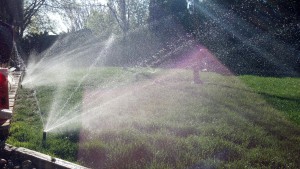How to Save Your Lawn With Proper
Sprinkler Controller Programming.
Proper watering is the most important, number one priority to your lawn and landscape here in the high desert of Denver, Colorado and the surrounding suburbs. Without proper watering… your fertilizing, aerating, spraying, and mowing will not give you the results you are looking for. It all starts and happens because of the water.
Proper watering will provide deep watering and deep root penetration. If you water as instructed below regularly for the life of your lawn, it will lead to a very healthy lawn and a lawn that is more tolerant, getting through drought, diseases and weed problems with ease. As long as you are properly fertilizing, aerating and mowing, of course.
Screw driver test:
To see if your lawn is wet enough any time of year, take a medium sized to large flat head screw driver and push it into the soil of your lawn. If it is difficult to push it in, then the soil is either too dry or you have a lot of rock in your soil. If it goes in easily, then your moisture level is good. If it goes in easily, but sloppy, and there is standing water in the hole you just made, you have too much water, depriving the roots of oxygen because they are drowning.
Water in Cycles:
Watering in cycles is best for your lawn. To water in cycles, you will water each zone/station, then immediately water each zone/station again, then immediately water each zone/station for a third time. You want to do this on each and all of your watering days.
These shorter, consecutive cycles create a deep watering by wetting the top layer the first round, then soaking into the soil a little deeper with each consecutive cycle. Having shorter run times on these cycles also prevents run off and waste onto the sidewalks and gutters. If you dump water on hard, compact soil for too long, it will start to run off because the soil cannot absorb the water at the rate you are putting it down. Watering in short cycles is going to give the water time to absorb into the lawn between each cycle.
When you water deep by watering in cycles and skip a day or two in between watering days, the roots will automatically penetrate deeper into the soil because they are trying to find water. When you skip a day in between watering schedules, the top layer will dry out but the deep soil will still be wet, encouraging the roots to penetrate deeper to reach the deep water. This is how you create a deep root zone.
If you currently water every day, you shouldn’t.
Watering every day creates a situation where there is always water on the surface, resulting in a shallow root system and a lot of thatch (thatch is a shallow root system, not debris in the lawn). When it gets hot, your lawn will stress out more quickly than a lawn that has deep roots from deep watering and skipping days. When you have a lot of thatch, you get more runoff since the thatch layer prevents a lot of water from soaking directly into the soil. One problem leads to another in your lawn when not watered properly.
If you water once in the morning and once at night each day (or on the days that you water), you are harming your lawn.
Watering in the morning and evening is harmful because you are watering just enough to wet the surface each time and the soil dries out in between each watering time. As a result, the roots never penetrate deep into the soil, making your lawn weak with a lot of thatch. It will be prone to disease and will succumb to heat stress quicker and will generally have more weeds.
Watering daily and/or at the wrong time of day increases the chances of getting a fungus in your lawn.
When you water at night (between 7pm-1am), the moisture sits on your lawn all night. In the summer when it is warm at night, the moisture and warm temperatures are a prime breeding ground for fungus problems.
So with all that in mind….. I have put together a good watering schedule that you can try out for 2 weeks.
Try this and keep in mind that you may need to make adjustments to it from there. If you start this program, I think you will see a great improvement over a 2 week period. Of course, creating a deep root zone will take a few years, not two weeks, but you may as well start now.
Try putting this into your sprinkler controller/timer:
1) Clear out all information from Programs A, B, C, and D (if you have that many programs), so they don’t interfere with your new program. You will only be using Program A.
2) Make sure the time and date are correct
3) Put in a new backup 9 volt battery, if applicable.
4) Watering Days:
Spring an Fall: Program 3 days per week, skipping a day in between each day. For example: Monday, Wednesday, Friday
Mid Summer: Add a fourth day, if the lawn is drying out (It usually does when the summer heat hits). For example: add Saturday or Sunday during this time.
Schedule watering your lawn so that you do not water the night before/morning of when you mow.
5) Station/Zone Run Times – this depends on the type of head on that particular station/zone:
-
Pop-up Spray Heads: (These don’t turn) 5-7 minutes each cycle.
-
Rotor Heads: (These Turn) 12-15 minutes each cycle.
-
Drip System: 15-20 minutes each cycle.
-
Micro sprays: (Typically on a drip system – They look like miniature pop-up spray heads) 5-7 minutes each cycle, but if they are mixed with drip emitters on the same zone then you need to water 15-20 minutes to get the drip emitters enough water.
-
Stream Rotors: (These heads look like spider legs that turn) 15-20 minutes each cycle.
-
Remember, you will be running theses cycles 3 x per watering day. See the next paragraph.
Cycle Start Times: To determine this, add up the amount of time it will take to go through your zones one time by adding up the times that you entered above on all zones and make sure you put enough time in between cycle start times to go through all zones once.
Most average residential landscapes are 1-1.5 hours of watering time in between cycles starts – For example if you have 4 zones and the total time to water is 36 minutes after you add up the station/zone run times, your start times should be 3am, 4am, and 5am (1 hour apart). If you have 7 zones and the total watering time is 1hr and 18 minutes after adding up your station/zone run times, your start times should be 2am, 3:30am, and 5am (1.5 hours apart).
You always want to water early in the morning, if possible. The sprinklers will finish all three cycles right before the sun comes up to dry off the surface of the lawn. There is generally less wind and you can prevent fungus problems by doing this.
You only have to use program A for this program. Programs B, C, and D (If applicable) are not required unless you have a garden or new seed/sod, etc. that requires a different watering schedule. For example if you lay new sod, you should water daily, 3 times per day. You can put a separate program on Program B to water the area of new sod without over watering all of the other zones.
Try this program out for a couple of weeks.
I think you will see great results from it. If you need to make adjustments to it, just add or subtract a minute or two from the run time of each zone that needs adjusting. If a zone is too wet subtract a minute (you will actually be subtracting 3 minutes since there are 3 cycles), and if a zone is too dry add a minute to that zone’s run time. If the entire yard remains dry after some minor adjustments, add a day. Go from 3 days to 4 days, but don’t water more than 4 days per week, you shouldn’t need to.
More Watering Tips:
-
For those of you who have a seasonal percentage adjustment on your sprinkler clock, you will need to make sure that your sprinkler clock is set to water at 100%
-
Always turn your sprinkler clock to the “Off” position for a day or two if you get 1/4″ or more rain at your house. DON’T FORGET TO TURN IT BACK ON A DAY OR TWO LATER!
-
In the event of a dry winter, you need to winter water your trees, shrubs and lawn. Give them all a really good soaking at least once per month, but twice is even better. You don’t have to use your winterized sprinkler system, just do it the old fashioned way with a garden hose and sprinkler.
-
If you are watering enough and you still have dry/brown spots/patches, you most likely have an inefficient sprinkler system with coverage issues. Don’t worry, most sprinkler systems function at about 60% efficiency, so this is very common. Issues, such as dry/brown patches will show up when it’s hot and there isn’t any supplemental rain fall. The good news is that this is usually something that we can fix with adjustments to sprinkler heads or nozzles, or by replacing heads with better, more efficient heads that cover more effectively. Let us know if you need help with this.












